
Architectural Styles and Revivals: The Italianate Style
(written by Dr. Les Crocker, UWL Emeritus Professor of Art History)
Italianate means ‘like something in Italy.’ Not a very specific definition for a style of building in the United States, especially in La Crosse which had few Italian immigrants. The Italianate is almost entirely a domestic style, there are very few public, religious, or commercial examples of the style in the United States and none in La Crosse, although some people call anything with a bracket Italianate.
Many of the designs for buildings and architectural details used by architect William H. J. Nichols in the La Crosse area were based on architectural design books, especially Samuel Sloan‘s The Model Architect, first published in 1852. It was a beautiful volume and took the concept of an architectural book to a whole new level of visual delight. Intended for the gentleman admirer of architecture, as much as for the carpenter or builder, Sloan’s book showed buildings in what was considered an appropriate setting and created an imaginary place that the client could relate to.
Early Italianate
The Tuteur House, 101 S. 9th St., 1856
The Tuteur House seems to have the earliest Italianate features remaining in La Crosse. The house plan begins with the traditional two rooms on each side of a central stair hall with a formal center entrance. A top light over the entrance is present, but there are no sidelights. The double-leaf door is a new feature--part of the Italianate style.
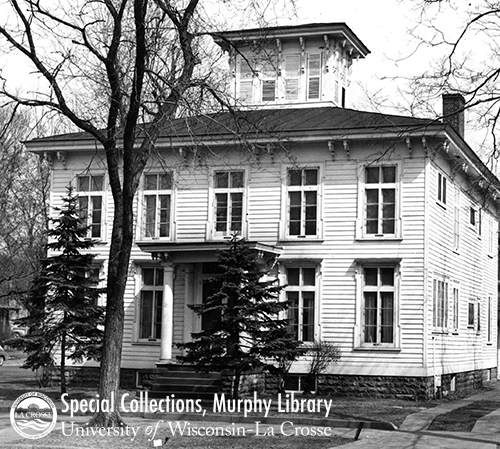
The Tuteur House is pictured here in 1948.
The five-bay front with center entrance is the basis of the house, but a cupola on the roof appears for the first time in La Crosse. Cupolas had long been used on barns and public buildings to increase ventilation, but Samuel Sloan’s book popularized them for use on houses.
The Tuteur cupola is well proportioned to the house size and similar to the cupolas on the Martindale house and the Daniel Cameron house in La Crescent.
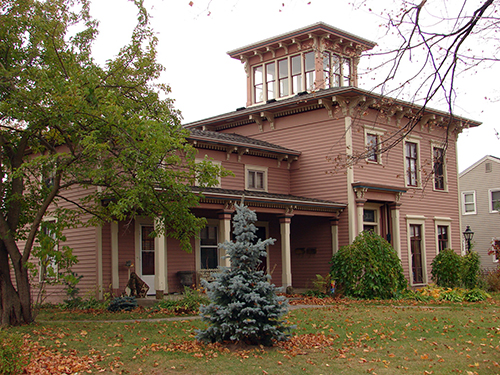
The Daniel Cameron house, La Crescent, MN. 2012 photo by author.
In later examples, Nichols reduced the size of the cupola, possibly to make the house look larger, such as the Van der Zee house in West Salem.
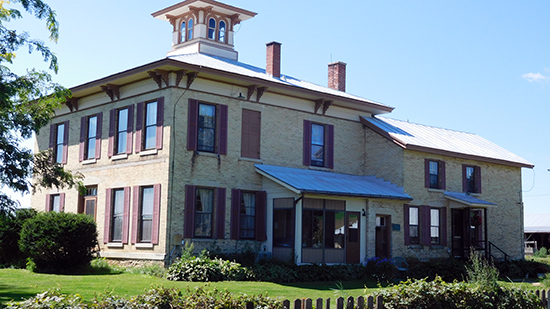
The Van der Zee house in West Salem, featuring a smaller cupola. 2016 photo by author.
The windows of the Tuteur house have two vertical rows of lights while the window frames are a distinctive shape taken from Sloan’s book.
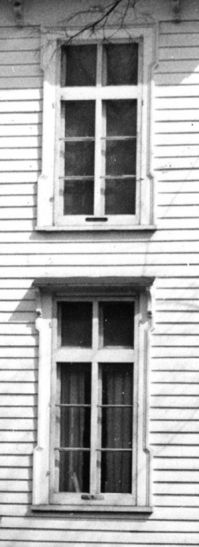
Detail of the windows of the Tuteur house.
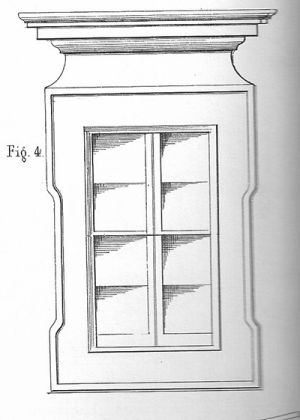
A window design from The Model Architect by Samuel Sloan.
The same window design would be used on the Martindale house and several other houses in town.
Brackets under the eaves replace the traditional entablature. The placing of the brackets is delightfully subtle - a pair of brackets between the windows and one at the corner. Smaller pairs of brackets are at the corners of the porch roof eave. The porch columns are not original, they probably replaced simple square columns sometime in the 1890s when people were adding Colonial Revival porches as a way of “modernizing” their houses. The cupola was removed sometime after 1948.
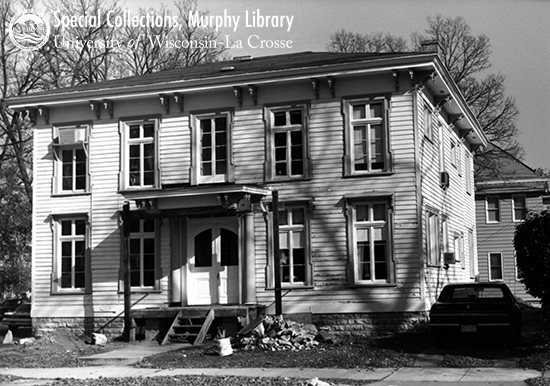
The Tuteur House in 1993. The cupola has been removed and the porch is under construction.
The Tuteur house shows how Nichols first used the designs of Sloan and these ideas would become a significant part of the architectural heritage of La Crosse.
Martindale House, 237 S. 10th St., ca. Mid-1850s
The Martindale house at 237 S. 10th St. was begun by a man named Laverty some time in the mid-1850s; the length of his ownership is unclear. Stephen Martindale bought the property and about 1865 added a new front with a stair hall and parlor. There is a double-leaf front door with a top light above it. The older house was several feet lower than the new addition and can clearly be seen behind the new front.

The Martindale House. 2021 photo by author.

The cupola has four, round-arched windows on the north and south sides and three on the east and west sides; smaller brackets echo the larger ones below. Everything is related to all the other parts. 2012 photo by author.
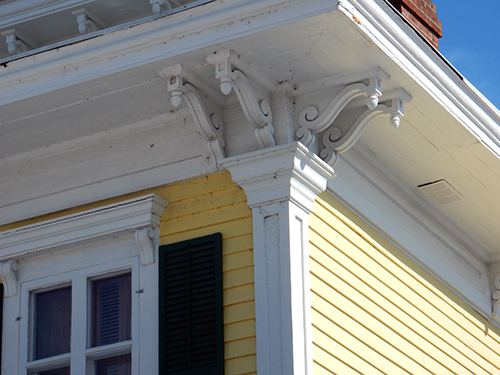
Deep eaves with brackets, distinctive windows, almost floor to ceiling, with two vertical rows of four panes on the ground floor and three panes in the second are all based on Sloan.
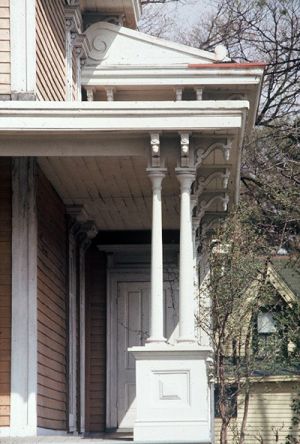
Colonettes, small diameter columns, supporting the porch roof are raised on pedestals, not to make them taller, he could have just used taller colonettes, but to make them grander. 1978 photo by author.
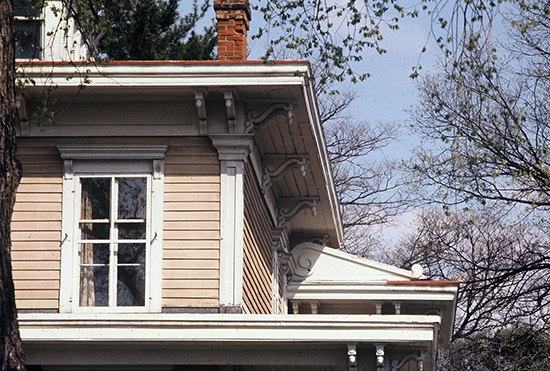
Pilasters with capitals are at the corners of the new section, making a vague reference to columns that were used in the classical revivals. The curved form on the far right of the porch is a simple way of hiding the difference in the roof heights. 1978 photo by author.
The Rumsey house at 303 S 11th shows many similarities to the Martindale addition, but with far fewer details. It was a less expensive house and also had a similar device to hide the roof height.

An 1881 engraving of the Rumsey house, here referred to as the C.L. Colman residence, printed in Butterfield’s History of La Crosse County, Wisconsin.
The Italianate Grand Mansions of the 1870s
While the Italianate style appeared in La Crosse soon after the publication of Sloan’s book, it wasn't until the 1870s when the first grand houses appear. Certainly there were earlier houses that were considered to be mansions, but the 1870s brought a new level of opulance for the upper- and upper-middle classes.
By the 1870s, housing was no longer as mixed as in the earler years. Some additions to the city had various sized lots which were priced according to their size. Consequently, some areas had groups of large houses. Cass Street became the street of wealth, as was West Avenue from State Street to Cameron Avenue. Sloan advocated such separation and reflected this in his terminology: mansions are in the city and have a more compact plan, often with a tower in the center of the facade.
Sloan’s second type of large house, the villa, is a large house more appropriate for the country with a sprawling plan of intersecting rectangles with several porches and the tower was placed in the angle of an L plan. The tower could be on the left or right of the interesecting rectangles, it was a flipable plan that could be built either way.
Sloan didn’t just use engravings of house designs, he set the major design as part of a landscape; He gave the house a context. It didn't matter that palm trees don’t grow in La Crosse. The environment was optional although I imagine the image always remained in the mind of the owner of the house.
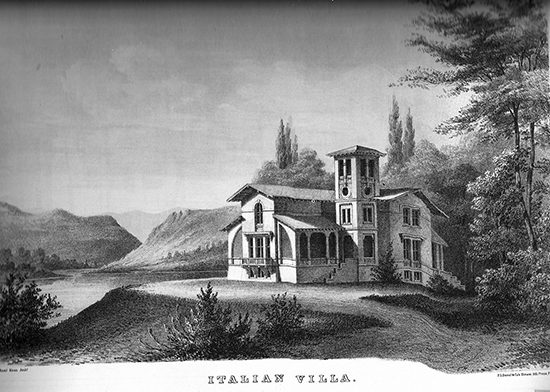
This engraving from Sloan’s book not only sells a design, but a whole aesthetic. Are you in the Tuscan hills or nestled in the La Crosse bluffs?
Levi Withee House, 211 S. 6th St., 1874; demolished
The Levi Withee house was a great example of this type of house. The design is based on Sloan's book with some obvious differences.
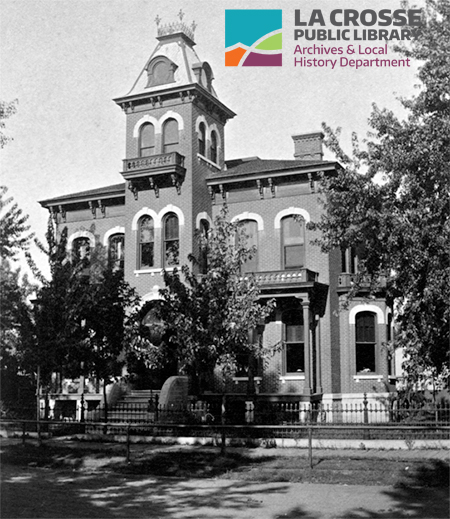
The Levi Withee home is an example of a grand mansion in the Italianate style.
Basically it is a typical five-bay, two-story house, probably with a central hall, but now with a grand tower in the center of the facade, and with appropriate window and door framing. It is raised on a limestone base with steps leading to the grand entrance. The square tower has a square cap with sloping sides leading to a grand finish at the peak.
The hooded windows in the tower roof are a simple reference to the Second Empire style but the roof is hipped, not a mansard. There is an iron crest at the tower top.
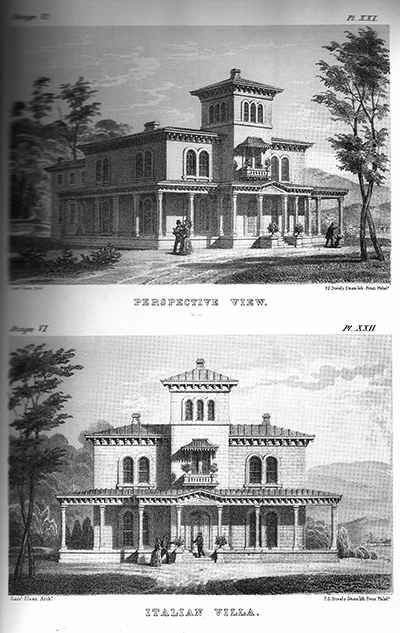
Example of grand house designs featuring a center tower from Sloan’s The Modern Builder.
Sloan’s design has a wide, deep porch suitable for the South but this house had and a non-functional porch on each side of the tower with decorative Italianate posts, and ballastrade but was they were too narrow for any real use.
The Gould House, 1502 Market St., 1876
The house at 1502 Market Street has been a curiousity for many years. The wide eaves, large eave brackets, and the two-story bay window are typical for the Italianate style, but the top of the tower-like part is not from the Italianate style and unlike anything else in town. The original front porch has been enclosed, vinyl siding covers the original brick, and the shape of some windows has been changed but the 1876 house is still there.

The Gould house at 1502 Market still offers some clues to its original Italianate style: the brackets and dentil molding under the eaves, as well as the posts supporting the third-floor porch enclosure. 2011 photo by author.
Demester Gould was born in Jefferson County, New York, in 1822. He came to Wisconsin in 1846, settling near Milwaukee. In 1849 the twenty-seven year old Gould traveled by wagon train to California, one of many young men in search of gold. He is listed in La Crosse in the U.S. Census of 1860. We don't know how Gould made a living when he first came to La Crosse but in the first La Crosse City Directory, from 1866, his occupation is milkman. He lived on Jackson street between 9th and 10th streets, an area that is blank on the 1867 birdseye view map. Gould’s dairy was out in the country in 1866, but close enough to town for easy milk delivery.
The dairy business must have been kind to Gould because on November 25, 1876, the building list in the La Crosse Democrat records him building a brick house at 15th and Market streets that was two-stories and measured 22 x30 with a one-story wing measured 16 x 32 for a value of $2200.
Gould’s house originally looked much like the Levi Withee and Isaac Moultan houses, part of the group of houses based on designs from Sloan’s book. The Gould house is the only remaining example of the tower in the center of the facade remaining in La Crosse.
Webb-Withee House, 236 S. 9th St., 1876
The Webb-Withee house at 236 S 9th at Cass was built in 1876 and this engraving of the house was used in Butterfield’s History of La Crosse Wisconsin in 1881. Only ten houses were used by Butterfield and they represented what he considered the best of La Crosse. The entrance is into the tower base; porches with Italianate square columns and ballastrades flank the tower entrance. The south wing has a bay window with paired windows above that Nichols used on many of his designs. The four-sided cap on the tower slopes like a mansard roof and there are hooded windows on each side to the cap. The paired windows are used again on the third story of the tower.
Unfortunately, the brick house was covered with a cement stucco early in the twentieth century, the tower was cut down, and a large, out-of-proportion porch built across the front.
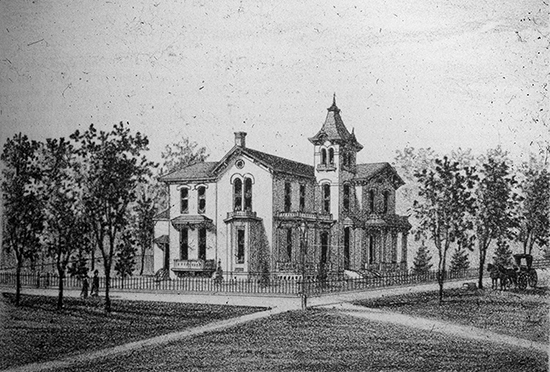
The Webb-Withee house as featured in Butterfield’s book.
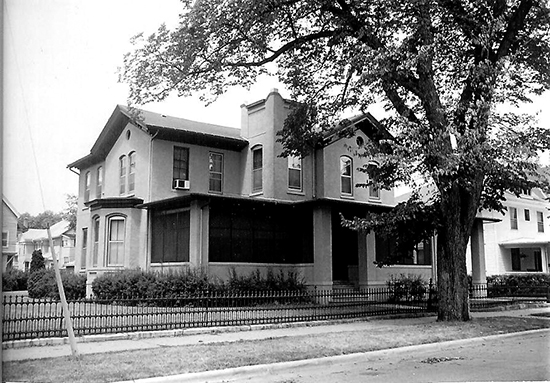
A recent photo of the house shows the changes to it over the last century. Photo by author.
G. Heileman House, 925 S. 3rd St., 1875
The G. Heileman house is now company offices, but the exterior has generally been preserved. The tower cap has been removed and the original porches replaced with some ugly brick pillars and modern railings. This house has the best remaining examplesof the stonework for window heads in town. There is a somewhat massive entablature with brackets at roof level and cornice returns are used on the gabled ends of the two wings, suggesting a pediment. The tower cap has the sloping sides of a mansard roof with round hooded windows. In spite of the alterations this house is the best remaining example of the towered villa in the area.

A photo of the home when it was still a residence for the Heileman family.

The home today serves as offices for the brewery. 2012 photo by author.
While Heileman built on 3rd Street to be near his brewery, Duncan McMillan built his house on the southeast corner of Cass Street and West Avenue, the social center of wealth in 1876. It uses the same design as the Heileman house, but with different details. Paired windows framed in stone with keystones on the round arches, dominate the house and would have provided a lot of light on the interior. A bay window to the right of the entrance is continued on the second floor in a slightly smaller version. The tower cap sits on a deep cornice and had extremely elaborate window frames around the windows set in the convex mansard roof.
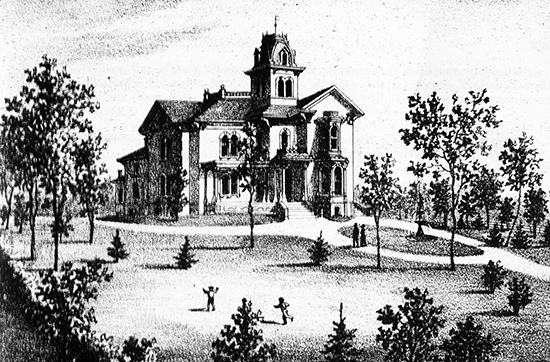
This engraving of the McMillan home from Butterfield’s book shows happy children playing in the yard.

An 1876 photo of the McMillan home shows how boldly the stone-framed windows are defined.
Next week, the series will continue with the Second Empire style!
Other entries in this series
Architectural Styles and Revivals
Architectural Styles and Revivals: The Greek and Roman Revivals
Architectural Styles and Revivals: The Gothic Revival
Architectural Styles and Revivals: The Exotic Revival
Architectural Styles and Revivals: The Second Empire Style
Architectural Styles and Revivals: The Queen Anne Style
Architectural Styles and Revivals: The Colonial Revival
Architectural Styles and Revivals: Romanesque Revival Public Buildings
Architectural Styles and Revivals: Romanesque Revival Commercial Buildings
Architectural Styles and Revivals: Romanesque Revival Homes
Architectural Styles and Revivals: Religious Romanesque
